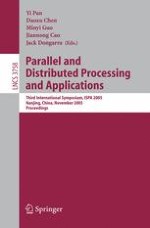Welcome to the proceedings of ISPA 2005 which was held in the city of Nanjing. Parallel computing has become a mainstream research area in computer science and the ISPA conference has become one of the premier forums for the presentation of new and exciting research on all aspects of parallel computing. We are pleased to present the proceedings for the 3rd International Symposium on Parallel and Distributed Processing and Applications (ISPA 2005), which comprises a collection of excellent technical papers, and keynote speeches. The papers accepted cover a wide range of exciting topics, including architectures, software, networking, and applications. The conference continues to grow and this year a record total of 968 manuscripts (including workshop submissions) were submitted for consideration by the Program Committee or workshops. From the 645 papers submitted to the main conference, the Program Committee selected only 90 long papers and 19 short papers in the program. Eight workshops complemented the outstanding paper sessions.
